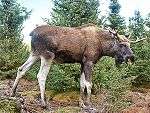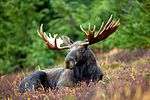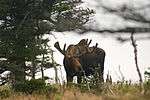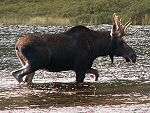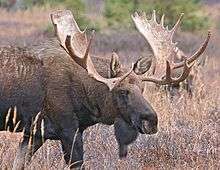Moose
The moose (North America) or elk (Eurasia), Alces alces, is a member of the New World deer subfamily and is the largest and heaviest extant species in the deer family. Male moose have distinctive broad, palmate ("open-hand shaped") antlers; other members of the deer family have antlers with a dendritic ("twig-like") configuration. Moose typically inhabit boreal forests and temperate broadleaf and mixed forests of the Northern Hemisphere in temperate to subarctic climates. Hunting and other human activities have caused a reduction in the size of the moose's range over time. It has been reintroduced to some of its former habitats. Currently, most moose occur in Canada, Alaska, New England (with Maine having the most of the lower 48 states), Fennoscandia, the Baltic states, and Russia. Its diet consists of both terrestrial and aquatic vegetation. The most common moose predators are the gray wolf along with bears and humans. Unlike most other deer species, moose do not form herds and are solitary animals, aside from calves who remain with their mother until the cow begins estrus (typically at 18 months after birth of the calf), at which point the cow chases away young bulls. Although generally slow-moving and sedentary, moose can become aggressive and move quickly if angered or startled. Their mating season in the autumn features energetic fights between males competing for a female.
| Moose | |
|---|---|
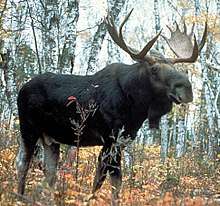 | |
| Male (bull) | |
%2C_Potter_marsh%2C_Alaska%2C_Estados_Unidos%2C_2017-08-22%2C_DD_139.jpg) | |
| Female (cow) | |
| Scientific classification | |
| Kingdom: | Animalia |
| Phylum: | Chordata |
| Class: | Mammalia |
| Order: | Artiodactyla |
| Family: | Cervidae |
| Subfamily: | Capreolinae |
| Genus: | Alces Gray, 1821 |
| Species: | A. alces |
| Binomial name | |
| Alces alces | |
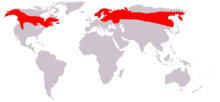 | |
| Moose range map | |
| Synonyms | |
|
Cervus alces Linnaeus, 1758 | |
| Look up moose in Wiktionary, the free dictionary. |
Etymology and naming
Alces alces is called a "moose" in North American English, but an "elk" in British English;[2] its scientific name comes from its name in Latin. The word "elk" in North American English refers to a completely different species of deer, Cervus canadensis, also called the wapiti. A mature male moose is called a bull, a mature female a cow, and an immature moose of either sex a calf.
The word "elk" originated in Proto-Germanic, from which Old English evolved and has cognates in other Indo-European languages, e.g. elg in Danish/Norwegian; älg in Swedish; alnis in Latvian; Elch in German; and łoś in Polish (Latin alcē or alcēs and Ancient Greek ἄλκη álkē are probably Germanic loanwords).[3] In the continental-European languages, these forms of the word "elk" almost always refer to Alces alces.
The word "moose" had first entered English by 1606[4] and is borrowed from the Algonquian languages (compare the Narragansett moos and Eastern Abenaki mos; according to early sources, these were likely derived from moosu, meaning "he strips off"),[5] and possibly involved forms from multiple languages mutually reinforcing one another. The Proto-Algonquian form was *mo·swa.[6]
The moose became extinct in Britain during the Bronze Age, long before the European arrival in the Americas. The youngest bones were found in Scotland and are roughly 3,900 years old.[7] The word "elk" remained in usage because of its existence in continental Europe; however, without any living animals around to serve as a reference, the meaning became rather vague to most speakers of English, who used "elk" to refer to "large deer" in general.[8] Dictionaries of the 18th century simply described "elk" as a deer that was "as large as a horse".[9]
Confusingly, the word "elk" is used in North America to refer to a different animal, Cervus canadensis, which is also called by the Algonquian indigenous name, "wapiti". The British began colonizing America in the 17th century, and found two common species of deer for which they had no names. The wapiti appeared very similar to the red deer of Europe (which itself was almost extinct in Southern Britain) although it was much larger and was not red.[8] The moose was a rather strange-looking deer to the colonists, and they often adopted local names for both. In the early days of American colonization, the wapiti was often called a gray moose and the moose was often called a black moose, but early accounts of the animals varied wildly, adding to the confusion.[10]
The wapiti is superficially very similar to the red deer of central and western Europe, although it is distinctly different behaviorally and genetically. Early European explorers in North America, particularly in Virginia where there were no moose, called the wapiti "elk" because of its size and resemblance to familiar-looking deer like the red deer.[11] The moose resembled the "German elk" (the moose of continental Europe), which was less familiar to the British colonists. For a long time neither species had an official name, but were called a variety of things. Eventually, in North America the wapiti became known as an elk while the moose retained its Anglicized Native-American name.[11] In 1736, Samuel Dale wrote to the Royal Society of Great Britain:
The common light-grey moose, called by the Indians, Wampoose, and the large or black-moose, which is the beast whose horns I herewith present. As to the grey moose, I take it to be no larger than what Mr. John Clayton, in his account of the Virginia Quadrupeds, calls the Elke ... was in all respects like those of our red-deer or stags, only larger ... The black moose is (by all that have hitherto writ of it) accounted a very large creature. ... The stag, buck, or male of this kind has a palmed horn, not like that of our common or fallow-deer, but the palm is much longer, and more like that of the German elke.[12]
Habitat, range, and distribution
Habitat
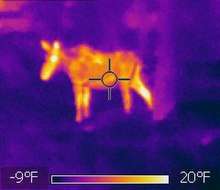
Moose require habitat with adequate edible plants (e.g., pond grasses, young trees and shrubs), cover from predators, and protection from extremely hot or cold weather. Moose travel among different habitats with the seasons to address these requirements.[13] Moose are cold-adapted mammals with thickened skin, dense, heat-retaining coat, and a low surface:volume ratio, which provides excellent cold tolerance but poor heat tolerance. Moose survive hot weather by accessing shade or cooling wind, or by immersion in cool water. In hot weather, moose are often found wading or swimming in lakes or ponds. When heat-stressed, moose may fail to adequately forage in summer and may not gain adequate body fat to survive the winter. Also, moose cows may not calve without adequate summer weight gain. Moose require access to both young forest for browsing and mature forest for shelter and cover. Forest disturbed by fire and logging promotes the growth of fodder for moose. Moose also require access to mineral licks, safe places for calving and aquatic feeding sites.[13]
Moose avoid areas with little or no snow as this increases the risk of predation by wolves and avoid areas with deep snow, as this impairs mobility. Thus, moose select habitat on the basis of trade-offs between risk of predation, food availability, and snow depth.[14] With reintroduction of bison into boreal forest, there was some concern that bison would compete with moose for winter habitat, and thereby worsen the population decline of moose. However, this does not appear to be a problem. Moose prefer sub-alpine shrublands in early winter, while bison prefer wet sedge valley meadowlands in early-winter. In late-winter, moose prefer river valleys with deciduous forest cover or alpine terrain above the tree line, while bison preferred wet sedge meadowlands or sunny southern grassy slopes.[15]
North America
.jpg)
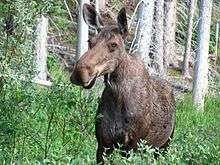
.jpg)
After expanding for most of the 20th century, the moose population of North America has been in steep decline since the 1990s. Populations expanded greatly with improved habitat and protection, but now the moose population is declining rapidly.[16] This decline has been attributed to opening of roads and landscapes into the northern range of moose, allowing deer to become populous in areas where they were not previously common. This encroachment by deer on moose habitat brought moose into contact with previously unfamiliar pathogens, including brainworm and liver fluke, and these parasites are believed to have contributed to the population decline of moose.[17] In North America, the moose range includes almost all of Canada (excluding the arctic and Vancouver Island), most of Alaska, northern New England and upstate New York, the upper Rocky Mountains, northern Minnesota, northern Wisconsin, Michigan's Upper Peninsula, and Isle Royale in Lake Superior. This massive range, containing diverse habitats, contains four of the six North American subspecies. In the West, moose populations extend well north into Canada (British Columbia and Alberta), and more isolated groups have been verified as far south as the mountains of Utah and Colorado and as far west as the Lake Wenatchee area of the Washington Cascades.[18][19] The range includes Wyoming, Montana, Idaho, and smaller areas of Washington and Oregon.[20] Moose have extended their range southwards in the western Rocky Mountains, with initial sightings in Yellowstone National Park in 1868, and then to the northern slope of the Uinta Mountains in Utah in the first half of the twentieth century.[21] This is the southernmost naturally established moose population in the United States.[21] In 1978, a few breeding pairs were reintroduced in western Colorado, and the state's moose population is now more than 1,000.
In northeastern North America, the Eastern moose's history is very well documented: moose meat was often a staple in the diet of Native Americans going back centuries, with a tribe that occupied present day coastal Rhode Island giving the animal its distinctive name, adopted into American English. The Native Americans often used moose hides for leather and its meat as an ingredient in pemmican, a type of dried jerky used as a source of sustenance in winter or on long journeys.[22] Eastern tribes also valued moose leather as a source for moccasins and other items.
The historical range of the subspecies extended from well into Quebec, the Maritimes, and Eastern Ontario south to include all of New England finally ending in the very northeastern tip of Pennsylvania in the west, cutting off somewhere near the mouth of the Hudson River in the south . The moose has been extinct in much of the eastern U.S. for as long as 150 years, due to colonial era overhunting and destruction of its habitat: Dutch, French, and British colonial sources all attest to its presence in the mid 17th century from Maine south to areas within a hundred miles of present-day Manhattan. However, by the 1870s, only a handful of moose existed in this entire region in very remote pockets of forest; less than 20% of suitable habitat remained.[23]
Since the 1980s, however, moose populations have rebounded, thanks to regrowth of plentiful food sources,[23] abandonment of farmland, better land management, cleanup of pollution, and natural dispersal from the Canadian Maritimes and Quebec. South of the Canada–US border, Maine has most of the population with a 2012 headcount of about 76,000 moose.[24] Dispersals from Maine over the years have resulted in healthy, growing populations each in Vermont and New Hampshire, notably near bodies of water and as high up as 3,000 ft (910 m) above sea level in the mountains. In Massachusetts, moose had gone extinct by 1870, but re-colonized the state in the 1960s, with the population expanding from Vermont and New Hampshire; by 2010, the population was estimated at 850–950.[25] Moose reestablished populations in eastern New York and Connecticut and appeared headed south towards the Catskill Mountains, a former habitat.[26][27][28][29][30][31][32]
In the Midwest U.S., moose are primarily limited to the upper Great Lakes region, but strays, primarily immature males, have been found as far south as eastern Iowa.[33] For unknown reasons, the moose population is declining rapidly in the Midwest.[16]
Moose were successfully introduced on Newfoundland in 1878 and 1904,[34] where they are now the dominant ungulate, and somewhat less successfully on Anticosti Island in the Gulf of Saint Lawrence.
Decline in population
Since the 1990s, moose populations have declined dramatically in much of temperate North America, although they remain stable in arctic and subarctic regions.[35] The exact causes of specific die-offs are not determined, but most documented mortality events were due to wolf predation, bacterial infection due to injuries sustained from predators, and parasites from whitetail deer to which moose have not developed a natural defense, such as liver flukes, brain worms and winter tick infestations.[16][36] Predation of moose calves by brown bear is also significant.[37] One of the leading hypotheses among biologists for generalized, nonhunting declines in moose populations at the southern extent of their range is increasing heat stress brought on by the rapid seasonal temperature upswings as a result of human-induced climate change.[38] Biologists studying moose populations typically use warm-season, heat-stress thresholds of between 14 and 24 °C (57 and 75 °F).[39] However, the minor average temperature increase of +1.5 to 2 °F change (+0.83 to 1.11 °C change), over the last 100 years, has resulted in milder winters that induce favorable conditions for ticks, parasites and other invasive species to flourish within the southern range of moose habitat in North America.[38] This leading hypothesis is supported by mathematical models that explore moose-population responses to future climate-change projections.[40]
The moose population in New Hampshire fell from 7,500 in the early 2000s to a current estimate of 4,000 and in Vermont the numbers were down to 2,200 from a high of 5,000 animals in 2005. Much of the decline has been attributed to the winter tick with about 70% of the moose calf deaths across Maine and New Hampshire due to the parasite. Moose with heavy tick infections will rub their fur down to the skin raw trying to get the ticks off, making them look white when their outer coat rubs off. Locals call them ghost moose.[41][42][43][44] Loss of the insulating winter coat through attempts to rid the moose of winter tick increases the risk of hypothermia in winter.[45]
Europe and Asia
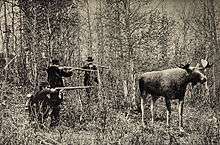
In Europe, moose are currently found in large numbers throughout Norway, Sweden, Finland, Latvia, Estonia, Poland, with more modest numbers in the southern Czech Republic, Belarus and northern Ukraine. They are also widespread through Russia on up through the borders with Finland south towards the border with Estonia, Belarus and Ukraine and stretching far away eastwards to the Yenisei River in Siberia. The European moose was native to most temperate areas with suitable habitat on the continent and even Scotland from the end of the last Ice Age, as Europe had a mix of temperate boreal and deciduous forest. Up through Classical times, the species was certainly thriving in both Gaul and Magna Germania, as it appears in military and hunting accounts of the age. However, as the Roman era faded into medieval times, the beast slowly disappeared: soon after the reign of Charlemagne, the moose disappeared from France, where its range extended from Normandy in the north to the Pyrenees in the south. Farther east, it survived in Alsace and the Netherlands until the 9th century as the marshlands in the latter were drained and the forests were cleared away for feudal lands in the former. It was gone from Switzerland by the year 1000, from the western Czech Republic by 1300, from Mecklenburg in Germany by c. 1600, and from Hungary and the Caucasus since the 18th and 19th century, respectively.
By the early 20th century, the very last strongholds of the European moose appeared to be in Fennoscandian areas and patchy tracts of Russia, with a few migrants found in what is now Estonia and Lithuania. The USSR and Poland managed to restore portions of the range within its borders (such as the 1951 reintroduction into Kampinos National Park and the later 1958 reintroduction in Belarus), but political complications limited the ability to reintroduce it to other portions of its range. Attempts in 1930 and again in 1967 in marshland north of Berlin were unsuccessful. At present in Poland, populations are recorded in the Biebrza river valley, Kampinos, and in Białowieża Forest. It has migrated into other parts of Eastern Europe and has been spotted in eastern and southern Germany.[46][47] Unsuccessful thus far in recolonizing these areas via natural dispersal from source populations in Poland, Belarus, Ukraine, Czech Republic and Slovakia, it appears to be having more success migrating south into the Caucasus. It is listed under Appendix III of the Bern Convention.[48][49]
In 2008, two moose were reintroduced into the Scottish Highlands[50][51] in Alladale Wilderness Reserve.[52]
The East Asian moose populations confine themselves mostly to the territory of Russia, with much smaller populations in Mongolia and Northeastern China. Moose populations are relatively stable in Siberia and increasing on the Kamchatka Peninsula. In Mongolia and China, where poaching took a great toll on moose, forcing them to near extinction, they are protected, but enforcement of the policy is weak and demand for traditional medicines derived from deer parts is high.[53] In 1978, the Regional Hunting Department transported 45 young moose to the center of Kamchatka. These moose were brought from Chukotka, home to the largest moose on the planet. Kamchatka now regularly is responsible for the largest trophy moose shot around the world each season. As it is a fertile environment for moose, with a milder climate, less snow, and an abundance of food, moose quickly bred and settled along the valley of the Kamchatka River and many surrounding regions. The population in the past 20 years has risen to over 2,900 animals.
The size of the moose varies. Following Bergmann's rule, population in the south (A. a. cameloides) usually grow smaller, while moose in the north and northeast (A. a. buturlini) can match the imposing sizes of the Alaskan moose (A. a. gigas) and are prized by trophy hunters.[54]
New Zealand
In 1900, an attempt to introduce moose into the Hokitika area failed; then in 1910 ten moose (four bulls and six cows) were introduced into Fiordland. This area is considered a less than suitable habitat, and subsequent low numbers of sightings and kills have led to some presumption of this population's failure.[55] The last proven sighting of a moose in New Zealand was in 1952.[56] However, a moose antler was found in 1972, and DNA tests showed that hair collected in 2002 was from a moose. There has been extensive searching, and while automated cameras failed to capture photographs, evidence was seen of bedding spots, browsing and antler marks.[57]
Populations
North America:
- In Canada : There are an estimated 500,000 to 1,000,000 moose [58] with 150,000 in Newfoundland in 2007 descended from just four that were introduced in the 1900s.[59]
- In United States : There are estimated to be around 300,000:
- Alaska: The state's Department of Fish and Game estimated 200,000 in 2011.[60]
- Northeast: A wildlife ecologist estimated 50,000 in New York and New England in 2007, with expansion expected.[31]
- Rocky Mountain states: Wyoming is said to have the largest share in its 6-state region, and its Fish and Game Commission estimated 7,692 in 2009.[61]
- Upper Midwest: Michigan estimated 433 (in its Upper Peninsula) in 2011,[62] Wisconsin Department of Natural Resources 20–40 (close to its upper-peninsula border with Michigan) in 2003, Minnesota 5600 in its northeast in 2010,[63] and under 100 in its northwest in 2009;[64] North Dakota closed, due to low moose population, one of its moose-hunting geographic units in 2011, and issued 162 single-kill licenses to hunters, each restricted to one of the remaining nine units.[65]
Europe and Asia:
- Finland : In 2009, there was a summer population of 115,000.[66]
- Norway : In 2009, there were a winter population of around 120,000.[67] In 2015 31,131 moose were shot. In 1999, a record number of 39,422 moose were shot.[68]
- Latvia : in 2015, there were 21,000.[69]
- Estonia : 13,260[70]
- Poland : 2,800[71]
- Czech Republic : maximum of 50[71]
- Russia : In 2007, there were approximately 600,000.[72]
- Sweden : Summer population is estimated to be 300,000–400,000. Around 100,000 are shot each fall.[73][74] About 10,000 are killed in traffic accidents yearly.[75]
Subspecies
| Eurasian elk
|
A. a. alces | Finland, Sweden, Norway, Latvia, Estonia, and Russia. No longer present in central and western Europe except for Poland, Lithuania and Belarus, with a certain population in the Czech Republic, Slovakia, and northern Ukraine, but can be observed in Bohemia since the 1970s and a tiny reintroduced population in Scotland, Great Britain, recently sighted in eastern Germany (range formerly included France, Switzerland, and the Benelux nations). Population increasing and regaining territory. Males weigh about 320 to 475 kg (705 to 1,047 lb) and females weigh 275 to 375 kg (606 to 827 lb) in this mid-sized subspecies. Shoulder height ranges from 1.7 to 2.1 m (5.6 to 6.9 ft).[76] |
| Yakutia moose, or mid-Siberian/Lena moose[77]
|
A. a. pfizenmayeri | Eastern Siberia, Mongolia, and Manchuria. Mostly found in forests of eastern Russia. The most common moose in Asia. Its ranging goes from the Yenisei River in the west and most of Siberia. Range excludes the ranges of the Chukotka and Amur moose to the east and Northern Mongolia. Similar in size to the western moose of Canada. |
| Ussurian or Amur or Manchurian moose[77][78] | A. a. cameloides | Ranges from Amur-Ussuri region of far eastern Russia, as well as the North Eastern part of China. Amur moose are different from other moose in that their antler size is much smaller, or lack any at all. Even adult bulls antlers are small and cervine with little palmation. It is the smallest moose subspecies in Asia and the world, with both males and females standing only 1.65 to 1.85 m (5.4 to 6.1 ft) at the shoulder and weigh between 200 and 350 kg (441 and 772 lb).[79] |
| Chukotka moose or east Siberian moose[77]
|
A. a. buturlini | Ranges from Northeastern Siberia from the Alazeya River basin east to the Kolyma and Anadyr basins and south through the Koryak range and Kamchatka Peninsula. Largest moose in Europe and Asia. Matches, and maybe even surpasses, the Alaskan moose (A. a. gigas), as the largest of the races and thus the largest race of deer alive. Bulls can grow up to 2.15 m (7.1 ft) tall and weigh between 500 and 725 kg (1,102 and 1,598 lb); females are somewhat smaller. |
| Eastern moose
|
A. a. americana | Eastern Canada, including eastern Ontario, all of Quebec, and the Atlantic Provinces. Northeastern United States including Maine, New Hampshire, Vermont, Massachusetts, Rhode Island, Connecticut, and northern New York near the Adirondack Mountains. Population increasing. This is a fairly small-bodied subspecies, females weighing an average of 270 kg (595 lb), males weighing an average of 365 kg (805 lb) and bulls stand up to approximately 2 m (6.6 ft) at the shoulder. |
| Western moose
|
A. a. andersoni | British Columbia to western Ontario, eastern Yukon, Northwest Territories, southwestern Nunavut, Michigan (Upper Peninsula), northern Wisconsin, northern Minnesota, and northeastern North Dakota. A mid-sized race that weighs 340 to 420 kg (750 to 926 lb) in adult females and 450 to 500 kg (992 to 1,102 lb) in adult males, on average.[80] |
| Alaskan moose
|
A. a. gigas | Alaska and western Yukon. The largest subspecies in North America, mass cited below.[81] |
| Shiras' moose
|
A. a. shirasi | Colorado, Idaho, Montana, Oregon, Utah, Washington, and Wyoming.[82] Smallest subspecies in North America, weighing about 230 to 344 kg (507 to 758 lb) at maturity. |
| † Caucasian moose or Caucasian elk[83]
|
A. a. caucasicus | Caucasus Mountains. Extinct due to loss of habitat and overhunting. Range would have included Iran, Russia, Georgia, Azerbaijan, and Turkey. |
Description and anatomy

Antlers
Bull moose have antlers like other members of the deer family. Cows select mates based on antler size. Bull moose use dominant displays of antlers to discourage competition and will spar or fight rivals.[84] The size and growth rate of antlers is determined by diet and age; symmetry reflects health.[84]
The male's antlers grow as cylindrical beams projecting on each side of the head at right angles to the midline of the skull, and then fork. The lower prong of this fork may be either simple, or divided into two or three tines, with some flattening. Moose antlers are broad and palmate (flat) with tines (points) along the outer edge.[84] Moose with antlers have more acute hearing than those without antlers; a study of trophy antlers using a microphone found that the palmate antler acts as a parabolic reflector, amplifying sound at the moose's ear.[85]
The antlers of mature Alaskan adult bull moose (5 to 12 years old) have a normal maximum spread greater than 200 centimeters (79 in). By the age of 13, moose antlers decline in size and symmetry. The widest spread recorded was 210 centimeters (83 in) across. (An Alaskan moose also holds the record for the heaviest weight at 36 kilograms (79 lb).)[84]
Antler beam diameter, not the number of tines, indicates age.[84] In North America, moose (A. a. americanus) antlers are usually larger than those of Eurasian moose and have two lobes on each side, like a butterfly. Eurasian moose antlers resemble a seashell, with a single lobe on each side.[84] In the North Siberian moose (A. a. bedfordiae), the posterior division of the main fork divides into three tines, with no distinct flattening. In the common moose (A. a. alces) this branch usually expands into a broad palmation, with one large tine at the base and a number of smaller snags on the free border. There is, however, a Scandinavian breed of the common moose in which the antlers are simpler and recall those of the East Siberian animals. The palmation appears to be more marked in North American moose than in the typical Scandinavian moose.
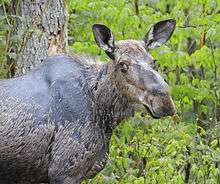
After the mating season males drop their antlers to conserve energy for the winter. A new set of antlers will then regrow in the spring. Antlers take three to five months to fully develop, making them one of the fastest growing animal organs. Antler growth is "nourished by an extensive system of blood vessels in the skin covering, which contains numerous hair follicles that give it a 'velvet' texture."[84] This requires intense grazing on a highly-nutritious diet. By September the velvet is removed by rubbing and thrashing which changes the colour of the antlers. Immature bulls may not shed their antlers for the winter, but retain them until the following spring. Birds, carnivores and rodents eat dropped antlers as they are full of protein and moose themselves will eat antler velvet for the nutrients.[84]
If a bull moose is castrated, either by accidental or chemical means, he will quickly shed his current set of antlers and then immediately begin to grow a new set of misshapen and deformed antlers that he will wear the rest of his life without ever shedding again. The distinctive-looking appendages (often referred to as "devil's antlers") are the source of several myths and legends among many groups of Inuit as well as several other tribes of indigenous peoples of North America.[86]
In extremely rare circumstances, a cow moose may grow antlers. This is usually attributed to a hormone imbalance.[87]
Proboscis and olfaction
The moose proboscis is distinctive among the living cervids due to its large size; it also features nares that can be sealed shut when the moose is browsing aquatic vegetation. The moose proboscis likely evolved as an adaptation to aquatic browsing, with loss of the rhinarium, and development of a superior olfactory column separate from an inferior respiratory column.[88] This separation contributes to the moose's keen sense of smell, which they employ to detect water sources, to find food under snow, and to detect mates or predators.[89][88]
Hooves
As with all members of the order Artiodactyla (even-toed ungulates), moose feet have two large keratinized hooves corresponding to the third and fourth toe, with two small posterolateral dewclaws (vestigial digits), corresponding to the second and fifth toe. The hoof of the fourth digit is broader than that of the third digit, while the inner hoof of the third digit is longer than that of the fourth digit. This foot configuration may favor striding on soft ground.[90] The moose hoof splays under load, increasing surface area, which limits sinking of the moose foot into soft ground or snow, and which increases efficiency when swimming. The body weight per footprint surface area of the moose foot is intermediate between that of the pronghorn foot, (which have stiff feet lacking dewclaws—optimized for high-speed running) and the caribou foot (which are more rounded with large dewclaws, optimized for walking in deep snow). The moose's body weight per surface area of footprint is about twice that of the caribou's.[91] [92]
On firm ground, a bull moose leaves a visible impression of the dewclaws in its footprint, while a cow moose or calf does not leave a dewclaw impression. On soft ground or mud, bull, cow, and calf footprints may all show dewclaw impressions.[94]
Fur
Their fur consist of two layers; top layer of long guard hairs and a soft wooly undercoat. The guard hairs are hollow and filled with air for better insulation, which also helps them stay afloat when swimming.[95]
Dewlap
Both male and female moose have a dewlap or bell,[96] which is a fold of skin under the chin. Its exact use is unknown, but theories state that it might be used in mating, as a visual and olfactory signal, or as a dominance signal by males, as are the antlers.[97]
Tail
The tail is short (6 cm to 8 cm in length) and vestigial in appearance; unlike other ungulates the moose tail is too short to swish away insects.[98]
Size and weight

On average, an adult moose stands 1.4–2.1 m (4.6–6.9 ft) high at the shoulder, which is more than a foot higher than the next largest deer on average, the wapiti.[99] Males (or "bulls") normally weigh from 380 to 700 kg (838 to 1,543 lb) and females (or "cows") typically weigh 200 to 490 kg (441 to 1,080 lb), depending on racial or clinal as well as individual age or nutritional variations.[100][101] The head-and-body length is 2.4–3.1 m (7.9–10.2 ft), with the vestigial tail adding only a further 5–12 cm (2.0–4.7 in).[102] The largest of all the races is the Alaskan subspecies (A. a. gigas), which can stand over 2.1 m (6.9 ft) at the shoulder, has a span across the antlers of 1.8 m (5.9 ft) and averages 634.5 kg (1,399 lb) in males and 478 kg (1,054 lb) in females.[103] Typically, however, the antlers of a mature bull are between 1.2 m (3.9 ft) and 1.5 m (4.9 ft). The largest confirmed size for this species was a bull shot at the Yukon River in September 1897 that weighed 820 kg (1,808 lb) and measured 2.33 m (7.6 ft) high at the shoulder.[104] There have been reported cases of even larger moose, including a bull killed in 2004 that weighed 1,043 kg (2,299 lb)[105], and a bull that reportedly scaled 1,180 kg (2,601 lb), but none are authenticated and some may not be considered reliable.[104] Behind only the two species of bison, the moose is the second largest of extant terrestrial wildlife after the bisons in North America, Siberia,[106] and Europe.
Ecology and biology
Diet
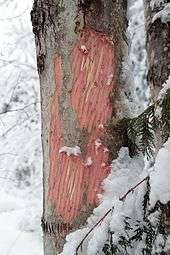
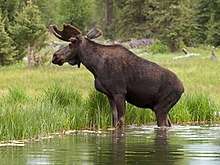
The moose is a herbivore and is capable of consuming many types of plant or fruit. The average adult moose needs to consume 9,770 kcal (40.9 MJ) per day to maintain its body weight.[107] Much of a moose's energy is derived from terrestrial vegetation, mainly consisting of forbs and other non-grasses, and fresh shoots from trees such as willow and birch. These plants are rather low in sodium, and moose generally need to consume a good quantity of aquatic plants. While much lower in energy, aquatic plants provide the moose with its sodium requirements, and as much as half of their diet usually consists of aquatic plant life.[108] In winter, moose are often drawn to roadways, to lick salt that is used as a snow and ice melter.[109] A typical moose, weighing 360 kg (794 lb), can eat up to 32 kg (71 lb) of food per day.[108]
Moose lack upper front teeth, but have eight sharp incisors on the lower jaw. They also have a tough tongue, lips and gums, which aid in the eating of woody vegetation. Moose have six pairs of large, flat molars and, ahead of those, six pairs of premolars, to grind up their food. A moose's upper lip is very sensitive, to help distinguish between fresh shoots and harder twigs, and is prehensile, for grasping their food. In the summer, moose may use this prehensile lip for grabbing branches and pulling, stripping the entire branch of leaves in a single mouthful, or for pulling forbs, like dandelions, or aquatic plants up by the base, roots and all.[110][111] A moose's diet often depends on its location, but they seem to prefer the new growths from deciduous trees with a high sugar content, such as white birch, trembling aspen and striped maple, among many others.[112] To reach high branches, a moose may bend small saplings down, using its prehensile lip, mouth or body. For larger trees a moose may stand erect and walk upright on its hind legs, allowing it to reach branches up to 4.26 meters (14.0 ft) or higher above the ground.[113][114]
Moose also eat many aquatic plants, including lilies and pondweed.[115] Moose are excellent swimmers and are known to wade into water to eat aquatic plants. This trait serves a second purpose in cooling down the moose on summer days and ridding itself of black flies. Moose are thus attracted to marshes and river banks during warmer months as both provide suitable vegetation to eat and water to wet themselves in. Moose have been known to dive underwater to reach plants on lake bottoms, and the complex snout may assist the moose in this type of feeding. Moose are the only deer that are capable of feeding underwater.[116] As an adaptation for feeding on plants underwater, the nose is equipped with fatty pads and muscles that close the nostrils when exposed to water pressure, preventing water from entering the nose.[117] Other species can pluck plants from the water too, but these need to raise their heads in order to swallow.

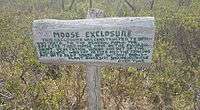
Moose are not grazing animals but browsers (concentrate selectors). Like giraffes, moose carefully select foods with less fiber and more concentrations of nutrients. Thus, the moose's digestive system has evolved to accommodate this relatively low-fiber diet. Unlike most hooved, domesticated animals (ruminants), moose cannot digest hay, and feeding it to a moose can be fatal.[118][119] The moose's varied and complex diet is typically expensive for humans to provide, and free-range moose require a lot of forested acreage for sustainable survival, which is one of the main reasons moose have never been widely domesticated.[120]
Natural predators
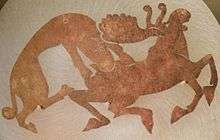
.jpg)
A full-grown moose has few enemies except Siberian tigers (Panthera tigris altaica) which regularly prey on adult moose,[121][122][123] but a pack of gray wolves (Canis lupus) can still pose a threat, especially to females with calves.[124] Brown bears (Ursus arctos)[103] are also known to prey on moose of various sizes, including many pregnant adult cows in some parts of Alaska and Scandinavia and even the rare bull moose, and are the only predator besides the wolf to attack moose both in Eurasia and North America. However, brown bears are more likely to take over a wolf kill or to take young moose than to hunt adult moose on their own.[125][126][127] American black bears (Ursus americanus) and cougars (Puma concolor) can be significant predators of moose calves in May and June and can, in rare instances, prey on adults (mainly cows rather than the larger bulls).[128][129] Wolverine (Gulo gulo) are most likely to eat moose as carrion but have killed moose, including adults, when the large ungulates are weakened by harsh winter conditions.[130][131] Killer whales (Orcinus orca) are the moose's only known marine predator as they have been known to prey on moose swimming between islands out of North America's Northwest Coast,[132] however, there is at least one recorded instance of a moose preyed upon by a Greenland shark.[133]
In some areas, moose are the primary source of food for wolves. Moose usually flee upon detecting wolves. Wolves usually follow moose at a distance of 100 to 400 meters (330 to 1,310 ft), occasionally at a distance of 2 to 3 kilometers (1.2 to 1.9 mi). Attacks from wolves against young moose may last seconds, though sometimes they can be drawn out for days with adults. Sometimes, wolves will chase moose into shallow streams or onto frozen rivers, where their mobility is greatly impeded. Moose will sometimes stand their ground and defend themselves by charging at the wolves or lashing out at them with their powerful hooves. Wolves typically kill moose by tearing at their haunches and perineum, causing massive blood loss. Occasionally, a wolf may immobilise a moose by biting its sensitive nose, the pain of which can paralyze a moose.[134] Wolf packs primarily target calves and elderly animals, but can and will take healthy, adult moose. Moose between the ages of two and eight are seldom killed by wolves.[135] Though moose are usually hunted by packs, there are cases in which single wolves have successfully killed healthy, fully-grown moose.[136][137]
Research into moose predation suggests that their response to perceived threats is learned rather than instinctual. In practical terms this means moose are more vulnerable in areas where wolf or bear populations were decimated in the past but are now rebounding. These same studies suggest, however, that moose learn quickly and adapt, fleeing an area if they hear or smell wolves, bears, or scavenger birds such as ravens.[138]
Moose are also subject to various diseases and forms of parasitism. In northern Europe, the moose botfly is a parasite whose range seems to be spreading.[139]
Social structure and reproduction
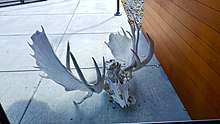
Moose are mostly diurnal. They are generally solitary with the strongest bonds between mother and calf. Although moose rarely gather in groups, there may be several in close proximity during the mating season.
Rutting and mating occurs in September and October. During the rut, mature bulls will cease feeding completely for a period of approximately two weeks; this fasting behavior has been attributed to neurophysiological changes related to redeployment of olfaction for detection of moose urine and moose cows.[140] The males are polygamous and will seek several females to breed with. During this time both sexes will call to each other. Males produce heavy grunting sounds that can be heard from up to 500 meters away, while females produce wail-like sounds.[141] Males will fight for access to females. Initially, the males assess which of them is dominant and one bull may retreat, however, the interaction can escalate to a fight using their antlers.
Female moose have an eight-month gestation period, usually bearing one calf, or twins if food is plentiful,[142] in May or June.[143] Twinning can run as high as 30% to 40% with good nutrition[144] Newborn moose have fur with a reddish hue in contrast to the brown appearance of an adult. The young will stay with the mother until just before the next young are born. The life span of an average moose is about 15–25 years. Moose populations are stable at 25 calves for every 100 cows at 1 year of age. With availability of adequate nutrition, mild weather, and low predation, moose have a huge potential for population expansion.[144]
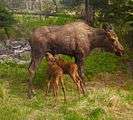 (newborn)
(newborn)
Calves nursing in spring.- (3 months)
Calves stay near their mothers at all times. - (9 months)
This calf is almost ready to leave its mother. - (10–11 months)
This yearling was probably recently chased away by its pregnant mother.
Aggression
Moose are not usually aggressive towards humans, but can be provoked or frightened to behave with aggression. In terms of raw numbers, they attack more people than bears and wolves combined, but usually with only minor consequences. In the Americas, moose injure more people than any other wild mammal, and worldwide, only hippopotamuses injure more.[145] When harassed or startled by people or in the presence of a dog, moose may charge. Also, as with bears or any wild animal, moose that have become used to being fed by people may act aggressively when denied food. During the fall mating season, bull moose may be aggressive toward humans because of the high hormone levels they experience. Cows with young calves are very protective and will attack humans who come too close, especially if they come between mother and calf. Unlike other dangerous animals, moose are not territorial, and do not view humans as food, and will therefore usually not pursue humans if they simply run away.[146]
Like any wild animal, moose are unpredictable. They are most likely to attack if annoyed or harassed, or if approached too closely. A moose that has been harassed may vent its anger on anyone in the vicinity, and they often do not make distinctions between their tormentors and innocent passers-by. Moose are very limber animals with highly flexible joints and sharp, pointed hooves, and are capable of kicking with both front and back legs. Unlike other large, hooved mammals, such as horses, moose can kick in all directions including sideways. Therefore, there is no safe side from which to approach. However, moose often give warning signs prior to attacking, displaying their aggression by means of body language. Maintained eye contact is usually the first sign of aggression, while laid-back ears or a lowered head is a definite sign of agitation. If the hairs on the back of the moose's neck and shoulders (hackles) stand up, a charge is usually imminent. The Anchorage Visitor Centers warn tourists that "...a moose with its hackles raised is a thing to fear."[147][148][149][150]
Studies suggest that the calls made by female moose during the rut not only call the males but can actually induce a bull to invade another bull's harem and fight for control of it. This in turn means that the cow moose has at least a small degree of control over which bulls she mates with.[151]
Moose often show aggression to other animals as well; especially predators. Bears are common predators of moose calves and, rarely, adults. Alaskan moose have been reported to successfully fend off attacks from both black and brown bears. Moose have been known to stomp attacking wolves, which makes them less preferred as prey to the wolves. Moose are fully capable of killing bears and wolves. A moose of either sex that is confronted by danger may let out a loud roar, more resembling that of a predator than a prey animal. European moose are often more aggressive than North American moose, such as the moose in Sweden, which often become very agitated at the sight of a predator. However, like all ungulates known to attack predators, the more aggressive individuals are always darker in color.[116]
Relationship with humans
History
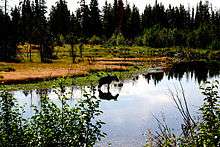
European rock drawings and cave paintings reveal that moose have been hunted since the Stone Age. Excavations in Alby, Sweden, adjacent to the Stora Alvaret have yielded moose antlers in wooden hut remains from 6000 BCE, indicating some of the earliest moose hunting in northern Europe. In northern Scandinavia one can still find remains of trapping pits used for hunting moose. These pits, which can be up to 4 × 7 m wide and 2 m deep, would have been camouflaged with branches and leaves. They would have had steep sides lined with planks, making it impossible for the moose to escape once it fell in. The pits are normally found in large groups, crossing the moose's regular paths and stretching over several kilometers. Remains of wooden fences designed to guide the animals toward the pits have been found in bogs and peat. In Norway, an early example of these trapping devices has been dated to around 3,700 BC. Trapping elk in pits is an extremely effective hunting method, and as early as the 16th century the Norwegian government tried to restrict their use. Nevertheless, the method was in use until the 19th century.
The earliest recorded description of the moose is in Julius Caesar's Commentarii de Bello Gallico, where it is described thus:
There are also [animals], which are called moose. The shape of these, and the varied color of their skins, is much like roes, but in size they surpass them a little and are destitute of horns, and have legs without joints and ligatures; nor do they lie down for the purpose of rest, nor, if they have been thrown down by any accident, can they raise or lift themselves up. Trees serve as beds to them; they lean themselves against them, and thus reclining only slightly, they take their rest; when the huntsmen have discovered from the footsteps of these animals whither they are accustomed to betake themselves, they either undermine all the trees at the roots, or cut into them so far that the upper part of the trees may appear to be left standing. When they have leant upon them, according to their habit, they knock down by their weight the unsupported trees, and fall down themselves along with them.[152]
In book 8, chapter 16 of Pliny the Elder's Natural History from 77 AD the elk and an animal called achlis, which is presumably the same animal, are described thus:
... there is, also, the moose, which strongly resembles our steers, except that it is distinguished by the length of the ears and of the neck. There is also the achlis, which is produced in the land of Scandinavia; it has never been seen in this city, although we have had descriptions of it from many persons; it is not unlike the moose, but has no joints in the hind leg. Hence, it never lies down, but reclines against a tree while it sleeps; it can only be taken by previously cutting into the tree, and thus laying a trap for it, as otherwise, it would escape through its swiftness. Its upper lip is so extremely large, for which reason it is obliged to go backwards when grazing; otherwise, by moving onwards, the lip would get doubled up.[153]
As food
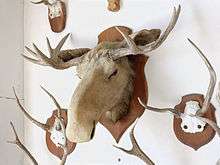
Moose are hunted as a game species in many of the countries where they are found. Moose meat tastes, wrote Henry David Thoreau in "The Maine Woods", "like tender beef, with perhaps more flavour; sometimes like veal". While the flesh has protein levels similar to those of other comparable red meats (e.g. beef, deer and wapiti), it has a low fat content, and the fat that is present consists of a higher proportion of polyunsaturated fats rather than saturated fats.[154]
Dr. Valerius Geist, who emigrated to Canada from the Soviet Union, wrote in his 1999 book Moose: Behaviour, Ecology, Conservation:
In Sweden, no fall menu is without a mouthwatering moose dish. The Swedes fence their highways to reduce moose fatalities and design moose-proof cars. Sweden is less than half as large as the Canadian province of British Columbia, but the annual take of moose in Sweden – upward of 150,000 – is twice that of the total moose harvest in North America.
Boosting of moose populations in Alaska for hunting purposes is one of the reasons given for allowing aerial or airborne methods to remove wolves in designated areas, e.g., Craig Medred: "A kill of 124 wolves would thus translate to [the survival of] 1488 moose or 2976 caribou or some combination thereof".[155] Some scientists believe that this artificial inflation of game populations is actually detrimental to both caribou and moose populations as well as the ecosystem as a whole. This is because studies have shown that when these game populations are artificially boosted, it leads to both habitat destruction and a crash in these populations.[156]
Caution about offal
Cadmium levels are high in Finnish elk liver and kidneys, with the result that consumption of these organs from elk more than one year old is prohibited in Finland.[157] As a result of a study reported in 1988, the Ontario Ministry of Natural Resources recommended against the consumption of moose and deer kidneys and livers. Levels of cadmium were found to be considerably higher than in Scandinavia.[158] The New Brunswick Department of Natural Resources advises hunters not to consume cervidae offal.[159]
Cadmium intake has been found to be elevated amongst all consumers of elk meat, though the elk meat was found to contribute only slightly to the daily cadmium intake. However the consumption of moose liver or kidneys significantly increased cadmium intake, with the study revealing that heavy consumers of moose organs have a relatively narrow safety margin below the levels which would probably cause adverse health effects.[160]
Vehicle collisions
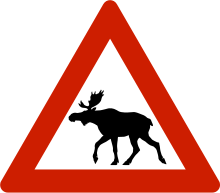
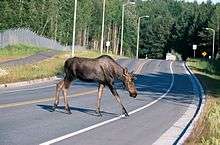
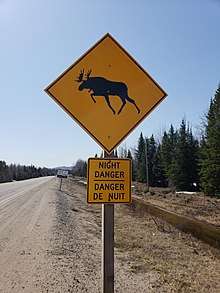
The center of mass of a moose is above the hood of most passenger cars. In a collision, the impact crushes the front roof beams and individuals in the front seats.[161] Collisions of this type are frequently fatal; seat belts and airbags offer little protection.[162] In collisions with higher vehicles (such as trucks), most of the deformation is to the front of the vehicle and the passenger compartment is largely spared. Moose collisions have prompted the development of a vehicle test referred to as the "moose test" (Swedish: Älgtest, German: Elchtest). A Massachusetts study found that moose–vehicular collisions had a very high human fatality rate and that such collisions caused the death of 3% of the Massachusetts moose population annually.[163]
Moose warning signs are used on roads in regions where there is a danger of collision with the animal. The triangular warning signs common in Sweden, Norway, and Finland have become coveted souvenirs among tourists traveling in these countries, causing road authorities so much expense that the moose signs have been replaced with imageless generic warning signs in some regions.[164]
In Ontario, Canada, an estimated 265 moose die each year as a result of collision with trains. Moose–train collisions were more frequent in winters with above average snowfall.[165] In January 2008, the Norwegian newspaper Aftenposten estimated that some 13,000 moose had died in collisions with Norwegian trains since 2000. The state agency in charge of railroad infrastructure (Jernbaneverket) plans to spend 80 million Norwegian kroner to reduce collision rate in the future by fencing the railways, clearing vegetation from near the tracks, and providing alternative snow-free feeding places for the animals elsewhere.[166]
In the Canadian province of New Brunswick, collisions between automobiles and moose are frequent enough that all new highways have fences to prevent moose from accessing the road, as has long been done in Finland, Norway, and Sweden. A demonstration project, Highway 7 between Fredericton and Saint John, which has one of the highest frequencies of moose collisions in the province, did not have these fences until 2008, although it was and continues to be extremely well signed.[167][168] Newfoundland and Labrador recommended that motorists use caution between dusk and dawn because that is when moose are most active and most difficult to see, increasing the risk of collisions.[169] Local moose sightings are often reported on radio stations so that motorists can take care while driving in particular areas. An electronic "moose detection system" was installed on two sections of the Trans-Canada Highway in Newfoundland in 2011, but the system proved unreliable and was removed in 2015.[170]
In Sweden, a road will not be fenced unless it experiences at least one moose accident per kilometer per year.[171]
In eastern Germany, where the scarce population is slowly increasing, there were two road accidents involving moose since 2000.[48]
Domestication
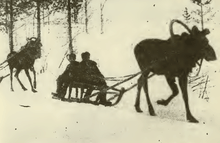
Domestication of moose was investigated in the Soviet Union before World War II. Early experiments were inconclusive, but with the creation of an moose-farm at Pechora-Ilych Nature Reserve in 1949 a small-scale moose domestication program was started, involving attempts at selective breeding of animals on the basis of their behavioural characteristics. Since 1963, the program has continued at Kostroma Moose Farm, which had a herd of 33 tame moose as of 2003. Although at this stage the farm is not expected to be a profit-making enterprise, it obtains some income from the sale of moose milk and from visiting tourist groups. Its main value, however, is seen in the opportunities it offers for the research in the physiology and behavior of the moose, as well as in the insights it provides into the general principles of animal domestication.
In Sweden, there was a debate in the late 18th century about the national value of using the moose as a domestic animal. Among other things, the moose was proposed to be used in postal distribution, and there was a suggestion to develop a moose-mounted cavalry. Such proposals remained unimplemented, mainly because the extensive hunting for moose that was deregulated in the 1790s nearly drove it to extinction. While there have been documented cases of individual moose being used for riding and/or pulling carts and sleds, Björklöf concludes no wide-scale usage has occurred outside fairytales.[172]
Paleontology
Moose are an old genus. Like its relatives, Odocoileus and Capreolus, the genus Alces gave rise to very few species that endured for long periods of time. This differs from the Megacerines, such as the Irish elk, which evolved many species before going extinct. Some scientists, such as Adrian Lister, grouped all the species into one genus, while others, such as Augusto Azzaroli, used Alces for the living species, placing the fossil species into the genera Cervalces and Libralces.
The earliest known species is Libralces gallicus (French moose), which lived in the Pliocene epoch, about 2 million years ago. Libralces gallicus came from the warm savannahs of Pliocene Europe, with the best preserved skeletons being found in southern France. L. gallicus was 1.25 times larger than the Alaskan moose in linear dimensions, making it nearly twice as massive. L. gallicus had many striking differences from its modern descendants. It had a longer, narrower snout and a less-developed nasal cavity, more resembling that of a modern deer, lacking any sign of the modern moose-snout. Its face resembled that of the modern wapiti. However, the rest of its skull structure, skeletal structure and teeth bore strong resemblance to those features that are unmistakable in modern moose, indicating a similar diet. Its antlers consisted of a horizontal bar 2.5 meters (8.2 ft) long, with no tines, ending in small palmations. Its skull and neck structure suggest an animal that fought using high-speed impacts, much like the Dall sheep, rather than locking and twisting antlers the way modern moose combat. Their long legs and bone structure suggest an animal that was adapted to running at high speeds over rough terrain.[173][174]
Libralces existed until the middle Pleistocene epoch and were followed briefly by a species called Cervalces carnutorum. The main differences between the two consisted of shortening of the horizontal bar in the antlers and broadening of the palmations, indicating a likely change from open plains to more forested environments, and skeletal changes that suggest an adaptation to marshy environments.
Cervalces carnutorum was soon followed by a much larger species called Cervalces latifrons (broad-fronted stag-moose). The Pleistocene epoch was a time of gigantism, in which most species were much larger than their descendants of today, including exceptionally large lions, hippopotamuses, mammoths, and deer. Many fossils of Cervalces latifrons have been found in Siberia, dating from about 1.2 to 0.5 million years ago. This is most likely the time at which the species migrated from the Eurasian continent to North America. Like its descendants, it inhabited mostly northern latitudes, and was probably well-adapted to the cold. Cervalces latifrons was the largest deer known to have ever existed, standing more than 2.1 meters (6.9 ft) tall at the shoulders. This is bigger than even the Irish elk (megacerine), which was 1.8 meters (5.9 ft) tall at the shoulders. Its antlers were smaller than the Irish elk's, but comparable in size to those of Libralces gallicus. However, the antlers had a shorter horizontal bar and larger palmations, more resembling those of a modern moose.[173][174][175]
Alces alces (the modern moose) appeared during the late Pleistocene epoch. The species arrived in North America at the end of the Pleistocene and coexisted with a late-surviving variety or relative of Cervalces latifrons, which Azzaroli classified as a separate species called Cervalces scotti, or the American stag-moose.[176]
See also
- Älgen Stolta, a rare example of a domesticated moose
References
- Hundertmark, K. (2016). "Alces alces". IUCN Red List of Threatened Species. 2016: e.T56003281A22157381. doi:10.2305/IUCN.UK.2016-1.RLTS.T56003281A22157381.en.
- "elk, n.1". Oxford English Dictionary. Retrieved 15 December 2010.
- "Online Etymology Dictionary – elk". Archived from the original on 21 September 2013. Retrieved 24 January 2013.
- "moose". Oxford English Dictionary (3rd ed.). Oxford University Press. September 2005. (Subscription or UK public library membership required.)
- "moose". Oxford English Dictionary (3rd ed.). Oxford University Press. September 2005. Retrieved 2011-02-16. (Subscription or UK public library membership required.)
- "moose". Dictionary.com Unabridged. Random House. Retrieved 2011-10-25.
- Feral: Rewilding the Land, the Sea, and Human Life By George Monbiot. University of Chicago Press. 2014. p. 124.
- Mallory, JP and DQ Adams (2006). The Oxford introduction to Proto-Indo-European and the Proto-Indo-European world Oxford University Press. Page 133
- Bailey, Nathan (1731). An Universal Etymological English Dictionary Royal Exchange. Page EL--EM.
- Royal Society (Great Britain) (1736). Philosophical Transactions and Collections, Volume 9. p.84.
- The Book of Animal Ignorance: Everything You Think You Know Is Wrong By John Mitchinson, John Lloyd -- Harmony Books 2007 Page 141
- Philosophical Transactions and Collections Volume 9 By Royal Society (Great Britain) 1736 Page 85
- Rines, Kristine. New Hampshire's moose population vs climate change (PDF) (Report). New Hampshire Fish and Game Department. Archived (PDF) from the original on 2018-05-16. Retrieved 2018-05-15.
- Dussault, Christian, Jean‐Pierre Ouellet, Réhaume Courtois, Jean Huot, Laurier Breton, and Hélène Jolicoeur. "Linking moose habitat selection to limiting factors." Ecography 28, no. 5 (2005): 619-628.
- Jung, Thomas S.; Czetwertynski, Sophie M.; Schmiegelow, Fiona K. A. (2018). "Boreal forest titans do not clash: low overlap in winter habitat selection by moose (Alces americanus) and reintroduced bison (Bison bison)". European Journal of Wildlife Research. 64 (3). doi:10.1007/s10344-018-1184-z.
- Robbins, Jim (14 October 2013). "Moose Die-Off Alarms Scientists". New York Times. Archived from the original on 10 December 2013. Retrieved 6 December 2013.
- "Archived copy". Archived from the original on 2019-04-20. Retrieved 2019-04-20.CS1 maint: archived copy as title (link)
- "Utah Division of Wildlife Resources". Wildlife.utah.gov. 2006-04-28. Archived from the original on October 5, 2007. Retrieved 2009-11-27.
- "Oregon moose population is booming". The Seattle Times. 2006-08-21. Archived from the original on 2010-04-17. Retrieved 2010-08-19.
- "ODFW Oregon Conservation Strategy News". Dfw.state.or.us. Archived from the original on 2013-07-06. Retrieved 2013-06-27.
- Wolfe, Michael L.; Hersey, Kent R.; Stoner, David C. (2010). "A History of Moose Management in Utah". Alces. 46: 37–52. Retrieved January 2, 2017.
- Cappelloni, Nancy (November 2002). Cranberry Cooking for All Seasons. Spinner Publications. p. 14. ISBN 978-0-932027-71-9. Archived from the original on 9 October 2013. Retrieved 25 June 2011.
- Wattles, David W. (2011). STATUS, MOVEMENTS, AND HABITAT USE OF MOOSE IN MASSACHUSETTS (PDF) (M.S. thesis). University of Massachusetts Amherst. Archived from the original on 2013-12-02. Retrieved 2013-11-22.
- "Survey estimates Maine has 76,000 moose". The Portland Press Herald / Maine Sunday Telegram. September 7, 2012. Archived from the original on December 2, 2013. Retrieved November 9, 2012.
- Wattles, David (2011). Status, Movements, and Habitat Use of Moose in Massachusetts. University of Massachusetts MS thesis. Archived from the original on 2013-12-02. Retrieved 2013-11-22.
- Living With Moose Archived 2010-06-08 at the Wayback Machine. Mass.gov (2007-09-20). Retrieved on 2011-01-09.
- Maine Department of Inland Fisheries and Wildlife – Moose Hunting Permits Archived 2007-10-15 at the Wayback Machine. Maine.gov. Retrieved on 2011-01-09.
- Connecticut Wildlife Sep/Oct 2004 Archived 2010-08-11 at the Wayback Machine. (PDF). Retrieved on 2011-01-09.
- Moose are on the Loose - Connecticut Public Broadcasting Network Archived 2010-06-22 at the Wayback Machine. Cpbn.org. Retrieved on 2011-01-09.
- Forests lure moose to Massachusetts / The Christian Science Monitor Archived 2010-11-08 at the Wayback Machine. CSMonitor.com (2007-02-14). Retrieved on 2011-01-09.
- "Archived copy". Archived from the original on 2010-08-04. Retrieved 2010-08-20.CS1 maint: archived copy as title (link)
- "Moose". Dec.ny.gov. NYS Dept. of Environmental Conservation. 1999-07-06. Archived from the original on 2011-07-28. Retrieved 2011-01-09.
- Franzman, Dave (5 December 2013). "A Moose Still on the Loose in Eastern Iowa". KCRG News 9. Archived from the original on 9 December 2013. Retrieved 6 December 2013.
- "tm Moose". Newfoundland Coastal Safari. Archived from the original on 2011-01-11. Retrieved 2011-02-06.
- "'Moose die-off' not seen in Yukon, where populations stable". cbc.ca. 16 October 2013. Archived from the original on 30 December 2014. Retrieved 15 December 2014.
- credits Hari Sreenivasan (2014-04-07). "What's devastating the wild moose population in New England?". PBS Newshour. Archived from the original on 2014-04-08. Retrieved 2014-04-08.
- Brockman, Christopher J., William B. Collins, Jeffery M. Welker, Donald E. Spalinger, and Bruce W. Dale. "Determining kill rates of ungulate calves by brown bears using neck-mounted cameras." Wildlife Society Bulletin 41, no. 1 (2017): 88-97.
- Cusick, Daniel (18 May 2012). "Rapid Climate Changes Turn North Woods into Moose Graveyard". Scientific American. Springer Nature. Archived from the original on 8 January 2018. Retrieved 8 January 2018.
- McCann, N.P.; Moen, R.A.; Harris, T.R. (30 October 2013). "Warm-season heat stress in moose (Alces alces)" (PDF). Canadian Journal of Zoology. 91 (12): 893–898. doi:10.1139/cjz-2013-0175. Archived (PDF) from the original on 13 November 2018. Retrieved 8 January 2018.
- Rempel, Robert S. (24 September 2011). "Effects of climate change on moose populations: Exploring the response horizon through biometric and systems models". Ecological Modelling. 222 (18): 3355–3365. doi:10.1016/j.ecolmodel.2011.07.012.
- Kusnetz, Nicholas (2017-05-29). "Climate Change Is Killing New England's Moose. Can Hunters Save Them?". InsideClimate News. Archived from the original on 2018-05-20. Retrieved 2018-06-04.
- "Ticks are killing 70 percent of moose calves across Maine, N.H." The Boston Globe. 2017-01-13. Archived from the original on 2018-06-22. Retrieved 2018-06-04.
- "Moose in New England face grisly deaths from tick infestations". Pri.org. 2017-03-18. Archived from the original on 2018-05-20. Retrieved 2018-06-04.
- MacQuarrie, Brian (2017-01-13). "Ticks devastate Maine, N.H. moose populations". The Boston Globe. Archived from the original on 2017-01-16. Retrieved 2017-01-16.
- Samuel, W. M. "Grooming by moose (Alces alces) infested with the winter tick, Dermacentor albipictus (Acari): a mechanism for premature loss of winter hair." Canadian Journal of Zoology 69, no. 5 (1991): 1255-1260.
- Schnfeld, Fiona (2009). "Presence of moose (Alces alces) in Southeastern Germany". European Journal of Wildlife Research. 55 (4): 449. doi:10.1007/s10344-009-0272-5.
- "Elks Make a Dangerous Comeback in Germany". Spiegel. 2012-09-03. Archived from the original on 2012-12-25. Retrieved 2012-12-28.
- Alces alces (Eurasian Elk, Moose, Elk, Eurasian Moose, European Elk, Siberian Elk) . Iucnredlist.org. Retrieved on 2011-01-09.
- "Wayward elk ‘Knutschi’ found dead – The Local Archived 2011-05-14 at the Wayback Machine". Thelocal.de. Retrieved on 2011-01-09.
- "Re-Introducing Moose to the Glen – Moose – BBC". 24 April 2009. Archived from the original on 29 April 2009. Retrieved 27 November 2009 – via YouTube.
- Cramb, Auslan; Eccleston, Paul (14 April 2008). "Moose to roam free again in Scotland". The Telegraph. Archived from the original on 27 January 2010. Retrieved 7 August 2011.
- "European Elk - Alces alces". alladale.com. Alladale Wilderness Reserve. Archived from the original on 19 January 2012. Retrieved 7 August 2011.
- "Ussurian moose". Bear Creek Journal. 2010-09-02. Archived from the original on 2013-06-24. Retrieved 2013-06-27.
- "This Ain't No Bullwinkle ... Check Out This Chukotka Kamchatka Moose". Gothunts.com. 1999-02-22. Archived from the original on 2014-03-15. Retrieved 2013-06-27.
- Caroline King, ed. (1995). The handbook of New Zealand mammals. Auckland, New Zealand: Oxford University Press in association with the Mammal Society, New Zealand Branch. ISBN 978-0-19-558320-5.
- "Deer and deer farming – Introduction and impact of deer". Te Ara – Encyclopedia of New Zealand. 1 March 2009. Archived from the original on 4 December 2011. Retrieved 27 March 2011.
- "Hairs move NZ moose out of realm of Nessie". NZ Herald. 2005-10-06. Archived from the original on 2007-09-30. Retrieved 2009-11-27.
- "Hinterland Who's Who". Hww.ca. Archived from the original on 2013-04-24. Retrieved 2013-05-25.
- "Newfoundland's 120,000 moose are descended from just four that were introduced a century ago". Canadacool.com. Archived from the original on 2011-07-24.
- Interior Alaska Moose News (Fall 2011) Archived 2016-02-20 at the Wayback Machine, p. 6, "How Do Scandinavia and Alaska Compare?"
- "Wyoming moose numbers fall short" Archived 2017-04-30 at the Wayback Machine, Billings Gazette, May 28, 2009
- "DNRE Survey Results Indicate Approximately 433 Moose in Western Upper Peninsula". Michigan.gov. 2017-05-25. Archived from the original on 2013-10-29. Retrieved 2018-06-04.
- "2010 Aerial Moose Survey" (PDF). Archived from the original (PDF) on 2017-08-08. Retrieved 2018-06-04.
- "Moose Management and Research Plan Update" (PDF). Archived (PDF) from the original on 2018-11-13. Retrieved 2018-06-04.
- "Big Game Hunting: Moose Season Information" Archived 2011-11-09 at the Wayback Machine, North Dakota Game and Fish Department
- RiistaWeb Archived 2010-07-24 at the Wayback Machine. Riistaweb.riista.fi. Retrieved on 2011-01-09.
- "Elgen truer skogen". Aftenposten (in Norwegian). Archived from the original on 2016-11-06. Retrieved 2016-09-19.
- "Elgjakt, 2015/2016". Statistisk sentralbyrå. Archived from the original on 2017-12-01. Retrieved 2016-09-19.
- "zm.gov.lv" (in Latvian). zm.gov.lv. Archived from the original on 2015-10-06. Retrieved 2015-10-06.
- "Põtrade arvukust tahetakse oluliselt vähendada." Archived 2013-06-27 at the Wayback Machine Postimees 06.26.2013. Retrieved on 6-27-2013. (in Estonian)
- "Factsheet: Eurasian Elk (Elk, reindeer, roe deer (Cetartiodactyla Cervidae Capreolinae) > Alces alces)". Lhnet.org. Archived from the original on 2013-07-27. Retrieved 2013-06-27.
- Baskin, Leonid M. (2009). "Status of Regional Moose Populations in European and Asiatic Russia". Alces. 45: 1–4. Archived from the original on 2018-02-26. Retrieved 2018-02-26.
- "jagareforbundet.se" (in Swedish). jagareforbundet.se. Archived from the original on 2013-12-03. Retrieved 2013-12-01.
- salenalgen.se Om älgar Archived 2012-06-20 at the Wayback Machine
- "Så många djur dödas i trafiken varje år | SvD". Svd.se. 2003-12-29. Archived from the original on 2018-09-25. Retrieved 2018-06-04.
- Smith, A. T., Xie, Y., Hoffmann, R. S., Lunde, D., MacKinnon, J., Wilson, D. E., & Wozencraft, W. C. (Eds.). (2010). A guide to the mammals of China Archived 2015-09-19 at the Wayback Machine. Princeton University Press.
- "Asian Moose". Bear Creek Journal. Archived from the original on 2013-06-20. Retrieved 2013-06-27.
- Kevin Jackson, 2009, Moose, Reaktion Books
- Jackson, K. (2009). Moose. Reaktion Books.
- "Moose in British Columbia" (PDF). Ministry of Environment, Lands and Parks, British Columbia. Archived (PDF) from the original on 2014-12-22. Retrieved 2014-08-18.
- Franzmann, A. W., LeResche, R. E., Rausch, R. A., & Oldemeyer, J. L. (1978). Alaskan moose measurements and weights and measurement-weight relationships. Canadian Journal of Zoology, 56(2), 298-306.
- "Moose Status and Hunting in Washington By Dana L. Base, Associate Wildlife Biologist August 2004". Archived from the original on June 21, 2007. Retrieved 2009-12-07.
- Wrobel, Murray (2006-11-18). Elsevier's Dictionary of Mammals. Elsevier. ISBN 9780080488820.
- Rodgers, Art (2001), "Appearance and characteristics", Moose, Voyager Press, pp. 24–27, ISBN 978-0-89658-521-8
- Bubenik, George A.; Bubenik, Peter G. (2008). "Palmated antlers of moose may serve as a parabolic reflector of sounds". European Journal of Wildlife Research. 54 (3): 533–5. doi:10.1007/s10344-007-0165-4. Lay summary – The Guardian (March 20, 2008).
- Geist, Valerius (1998) Deer of the World: Their Evolution, Behaviour, and Ecology Archived 2016-06-23 at the Wayback Machine Stackpole Books.
- It’s a Bull Moose…No a Cow… Archived 2012-01-20 at the Wayback Machine Joe Viechnicki, KFSK – Petersburg 10-19-09
- Pagano, Anthony Santino, Jeffrey T. Laitman, Kurt Albertine, and Samuel Marquez. "Evolution of the proboscis in the moose, Alces alces: Evidence from Morphology and Ecology." The FASEB Journal 33, no. 1_supplement (2019): 767-19.
- Márquez, Samuel, Anthony S. Pagano, Carrie S. Mongle, Kurt H. Albertine, and Jeffrey T. Laitman. "The Nasal Complex of a Semiaquatic Artiodactyl, the Moose (Alces alces): Is it a Good Evolutionary Model for the Ancestors of Cetaceans?." The Anatomical Record 302, no. 5 (2019): 667-692.
- Keller, Anna, Marcus Clauss, Evelyne Muggli, and Karl Nuss. "Even-toed but uneven in length: the digits of artiodactyls." Zoology 112, no. 4 (2009): 270-278.
- Lundmark, Caroline. Morphological and behavioral adaptations of moose to climate, snow, and forage. Vol. 2008, no. 67. 2008.
- Telfer, Edmund S., and John P. Kelsall. "Adaptation of some large North American mammals for survival in snow." Ecology 65, no. 6 (1984): 1828-1834.
- Pesaturo, Janet (17 April 2016). "Moose Hooves and Legs: Great Adaptations". ouroneacrefarm.com.
- "Moose Tracks - What do Tracks From A Moose Look Like?". All About Moose. Archived from the original on 2017-12-14. Retrieved 2018-07-14.
- "Big Game Hunting in Newfoundland". Newfoundlandbiggamehunting.com. 2016-01-17. Archived from the original on 2017-01-04. Retrieved 2018-06-04.
- "Moose". britannica.com. 1999-07-23. Archived from the original on 2018-10-02. Retrieved 2018-10-02.
- "Alces alces, Giant of the Northern Forest". bioweb.uwlax.edu. Archived from the original on 2018-02-08. Retrieved 2018-10-02.
- Robinson, Bruce (2019). Mesothelioma. Boca Raton: CRC Press. ISBN 1135285977.
- "Moose Facts from Maine". Jackmanmaine.org. Archived from the original on 2009-09-03. Retrieved 2009-11-27.
- "Moose". Env.gov.nl.ca. Archived from the original on January 2, 2008. Retrieved 2009-11-27.
- Franzmann, A. W. (1981). Alces alces. Mammalian Species, 1-7.
- Nowak, Ronald W., Walker's Mammals of the World. The Johns Hopkins University Press (1999), ISBN 978-0-8018-5789-8
- Long, Nancy; Savikko, Kurt (2009-08-07). "Moose: Wildlife Notebook Series – Alaska Department of Fish and Game". Adfg.state.ak.us. Archived from the original on 2009-11-30. Retrieved 2009-11-27.
- Wood, The Guinness Book of Animal Facts and Feats. Sterling Pub Co Inc. (1983), ISBN 978-0-85112-235-9
- World Record Moose Hunting
- Wood bison to be listed in Yakutia's Red Data Book
- "Info on moose diet from Norwestern University". Qrg.northwestern.edu. Archived from the original on 2011-03-10. Retrieved 2011-02-16.
- Biology by numbers: an encouragement to quantitative thinking By Richard F. Burton – Cambridge University Press 1998 Page 84-85
- Journey to New England By Patricia Harris, David Lyon – Patricia Harris-David Lyon 1999 Page 398
- Rodgers, Art (2001), Moose, Voyager Press, p. 34, ISBN 978-0-89658-521-8
- Seasons of the Moose By Jennie Promack, Thomas J. Sanker -- Gibbs Smith 1992 Page 21
- Moose diet Archived 2010-11-25 at the Wayback Machine. Mooseworld. Retrieved on 2011-01-09.
- North American big-game animals by Byron Dalrymple -- Stoeger Publishing 1983 Page 84
- The Land and Wildlife of North America By Peter Farb -- California State department of Education 1966 Page 177
- Moose diet Archived 2010-11-25 at the Wayback Machine Mooseworld. Retrieved on 2011-01-09.
- Deer of the World: Their Evolution, Behaviour, and Ecology By Valerius Geist -- Stackpole Books 1998 Page 237
- "USATODAY.com - Researchers take a look at the moose's enigmatic nose". usatoday.com. Archived from the original on 2014-05-18. Retrieved 2014-05-18.
- Comparative Animal Nutrition and Metabolism By Peter R. Cheeke, Ellen Sue Dierenfeld -- CABI 2010 Page 24
- MOWRY, TIM. "Deadly diet of hay can bring down a moose - Juneau Empire - Alaska's Capital City Online Newspaper". Archived from the original on 2016-03-01.
- Simon, Verne A. (11 March 2010). Adaptations in the Animal Kingdom. Xlibris Corporation. ISBN 9781450033664. Archived from the original on 9 January 2017. Retrieved 5 July 2016 – via Google Books.
- Frasef, A. (2012). Feline Behaviour and Welfare. CABI. pp. 72–77. ISBN 978-1-84593-926-7.
- Tigris Foundation dedicated to the survival of the Amur tiger and leopard in the wild : UK HOME Archived 2011-08-17 at the Wayback Machine. Tigrisfoundation.nl (1999-11-13). Retrieved on 2011-01-09.
- Hayward, M. W., Jędrzejewski, W., & Jedrzejewska, B. (2012). Prey preferences of the tiger Panthera tigris. Journal of Zoology, 286(3), 221-231.
- Long, Nancy; Savikko, Kurt (2007-12-17). "Wolf: Wildlife Notebook Series – Alaska Department of Fish and Game". Adfg.state.ak.us. Archived from the original on 2010-11-15. Retrieved 2009-11-27.
- Long, Nancy; Savikko, Kurt (2009-08-07). "Brown Bear: Wildlife Notebook Series – Alaska Department of Fish and Game". Adfg.state.ak.us. Archived from the original on 2009-11-29. Retrieved 2009-11-27.
- Opseth, O. (1998). Brown bear (Ursus arctos) diet and predation on moose (Alces alces) calves in the southern taiga zone in Sweden. Cand Sci Thesis, Norwegian University of Science and Technology, Trondheim.
- Mattson, D. J. (1997). Use of ungulates by Yellowstone grizzly bears Ursus arctos. Biological Conservation, 81(1), 161-177.
- Schwartz, Charles C. & Franzmann, Albert W. (1983). "Effects of Tree Crushing on Black Bear Predation on Moose Calves" (PDF). Bears: Their Biology and Management. A Selection of Papers from the Fifth International Conference on Bear Research and Management, Madison, Wisconsin, USA, February 1980. 5: 40–44. doi:10.2307/3872518. JSTOR 3872518. Archived (PDF) from the original on 2008-12-17. Retrieved 2008-12-10.
- "Hinterland Who's Who – Cougar". Hww.ca. Archived from the original on 2010-09-26. Retrieved 2009-11-27.
- Scrafford, Matthew A., and Mark S. Boyce. "Temporal patterns of wolverine (Gulo gulo luscus) foraging in the boreal forest." Journal of Mammalogy 99, no. 3 (2018): 693-701.
- "Gulo gulo – The American Society of Mammalogists" (PDF). smith.edu. Archived from the original (PDF) on 2012-06-17. Retrieved 2012-06-22.
- Baird, Robert W.; Baird, Robin W. (31 August 2006). Killer Whales of the World: Natural History and Conservation. Voyageur Press. pp. 23–. ISBN 978-0-7603-2654-1. Archived from the original on 21 July 2011. Retrieved 2 February 2011.
- "Moose-eating shark rescued in Newfoundland harbour". CBC Newfoundland & Labrador. Canadian Broatcasting Corporation. Archived from the original on 23 May 2016. Retrieved 15 May 2016.
- Graves, Will (2007). Wolves in Russia: Anxiety throughout the ages. Calgary: Detselig Enterprises. p. 222. ISBN 978-1-55059-332-7. OCLC 80431846. Archived from the original on 2009-08-02.
- "Watching Wolves On a Wild Ride By Les Line, National Wildlife Federation, December/January 2001, vol. 39 no. 1". Nwf.org:80. Archived from the original on 2008-03-08. Retrieved 2011-02-16.
- "Alaska Science Forum, June 10, 2004 Are ravens responsible for wolf packs? Article #1702 by Ned Rozell". Gi.alaska.edu. 2004-06-10. Archived from the original on 2010-11-24. Retrieved 2011-02-16.
- Carnivores of the World by Dr. Luke Hunter. Princeton University Press (2011), ISBN 9780691152288
- Berger, Joel; Swenson, Jon E.; Persson, Inga-Lill Recolonizing Carnivores and Naive Prey: Conservation Lessons from Pleistocene Extinctions. Science 2/9/2001
- Jaenson, Thomas G.T. (2011). "Larver av nässtyngfluga i ögat - ovanligt men allvarligt problem. Fall av human oftalmomyiasis från Dalarna och sydöstra Finland redovisas (summary)". Lakartidningen. 108 (16). Archived from the original on 2011-09-27. Retrieved 21 June 2011.
Moose bot fly larvae are common parasites of moose (Alces alces) in north and central Sweden. Last year, however, C. ulrichii was on three occasions recorded for the first time from Småland, south Sweden.
- Miquelle, Dale G. "Why don't bull moose eat during the rut?." Behavioral Ecology and Sociobiology 27, no. 2 (1990): 145-151.
- DW Hartt, Data; Coordinator, Web. "Moose Reproduction". Archived from the original on 2008-04-24. Retrieved 2011-02-16.
- Ruff, Sue (1999). The Smithsonian Book of North American Mammals. Washington: Smithsonian Institution Press. ISBN 978-1-56098-845-8.
- "Moose: Minnesota DNR". Archived from the original on 2009-12-07. Retrieved 2009-11-11.
- Crichton, Vince; A. T. Bergerud; James-Abra, Erin. "Moose". The Canadian Encyclopedia. Retrieved September 1, 2019.
- Adventure Guide Inside Passage & Coastal Alaska By Ed Readicker-Henderson, Lynn Readicker-Henderson -- Hunter Publishing 2006 Page 49
- "What To Do About Aggressive Moose, Division of Wildlife Conservation, Alaska Department of Fish and Game". wildlife.alaska.gov. Archived from the original on 2009-11-05. Retrieved 2009-11-06.
- Adventure Guide Alaska Highway By Ed Readicker-Henderson, Lynn Readicker-Henderson -- Hunter Publishing 2006 Page 416
- Explorer's Guide 50 Hikes Around Anchorage By Lisa Maloney -- The Countryman Press 2010 Page 16
- Field & Stream Aug 2002 -- Page 75--77
- Wilderness Camping & Hiking By Paul Tawrell -- Exxa Nature 2007 Page 161
- US Fed News Service, Female moose moans provoke bull fights, females have more choice in picking mates, concludes Idaho state university study 8/3/2011
- Caesar, Julius; Hirtius, Aulus (1879). "XXVII". Caesar's Commentaries on the Gallic and civil wars. Harper & brothers. p. 154. ISBN 978-0-217-45287-8.
- John Bostock; Henry Thomas Riley (eds.). "Pliny the Elder, The Natural History". Archived from the original on 2012-07-13. Retrieved 2009-11-08.
- "Moose, meat, raw (Alaska Native)". www.nutritiondata.com. Archived from the original on 2008-05-21. Retrieved 2011-02-16.
- adn.com Archived February 13, 2009, at the Wayback Machine
- Aerial Hunting FAQs Archived 2010-07-12 at the Wayback Machine, Defenders of Wildlife - Protect America's Wildlife (PAW) Act - Aerial hunting FAQs
- "All-clear for Finnish foods". www.foodqualitynews.com. Archived from the original on 2009-11-10. Retrieved 2009-11-06.
- Glooschenko, V.; Downes, C.; Frank, R.; Braun, H.E.; Addison, E.M.; Hickie, J. (June 1988). "Cadmium levels in Ontario moose and deer in relation to soil sensitivity to acid precipitation". Science of the Total Environment. 71 (2): 173–186. doi:10.1016/0048-9697(88)90165-9.
- "Health and Wellness Public Health Advisory / Hunters and wildlife diseases (05/09/16)" (NB 1188). www.gnb.ca. New Brunswick Chief Medical Officer of Health. 16 September 2005.
- Vahteristo, L., Lyytikäinen, T., Venäläinen, E. R., Eskola, M., Lindfors, E., Pohjanvirta, R., & Maijala, R. (2003). Cadmium intake of moose hunters in Finland from consumption of moose meat, liver and kidney. Food Additives and Contamination, 20, 453–463.
- "Archived copy" (PDF). Archived (PDF) from the original on 2012-03-11. Retrieved 2011-10-04.CS1 maint: archived copy as title (link)
- Traffic Management for a Sustainable Environment Number 2, 2004, of Nordic Road & Transport Research. Annotations Sweden
- Zeller, Katherine A.; Wattles, David W.; DeStefano, Stephen (2018). "Incorporating Road Crossing Data into Vehicle Collision Risk Models for Moose (Alces americanus) in Massachusetts, USA". Environmental Management. 62 (3): 518–528. doi:10.1007/s00267-018-1058-x. ISSN 0364-152X. PMID 29744581.
- (in Swedish) "Älgsafari lockar tusentals turister", Dagens Nyheter, August 12, 2007. Accessed November 6, 2009."
- Hamr, Joe, Mike Hall, and Jesse N. Popp. "AN ASSESSMENT OF MOOSE AND ELK TRAIN COLLISIONS IN ONTARIO, CANADA." Alces: A Journal Devoted to the Biology and Management of Moose 55 (2019): 1-12.
- "Railroad takes steps to reduce moose crashes". Aftenposten. 28 January 2008. Archived from the original on 28 September 2008.
- Moose-Vehicle Collision Information Archived 2007-01-14 at the Wayback Machine, New Brunswick Department of Transportation
- More wildlife fencing to be installed on Route 7 in 2008 Archived 2011-01-17 at the Wayback Machine, Communications New Brunswick, April 8, 2008
- "Highway Driving Conditions – Department of Transportation and Works". www.roads.gov.nl.ca. Archived from the original on 2008-05-13. Retrieved 2009-11-06.
- "Moose detection lights being removed, 'not effective' for N.L." CBC News. 10 February 2015. Archived from the original on 23 November 2015. Retrieved 11 February 2018.
- (in Swedish) Många viltolyckor – inget görs – Mellerud Archived 2011-07-19 at the Wayback Machine. www.ttela.se (2010-12-21). Retrieved on 2011-01-09.
- Björklöf, Sune. (1995). "Har älgar tämjts till kavalleri?" Archived 2011-07-14 at the Wayback Machine, Populär Historia, no 5. Visited 2010-05-17.
- Deer of the world: their evolution, behaviour, and ecology By Valerius Geist - Page 244-250
- Morphological Change in Quaternary Mammals of North America by Robert Allen Martin, Anthony D. Barnosky - Cambridge University Press 1993 Page 178-181
- "Cervalces latifrons | Natural History Museum". Nhm.ac.uk. Archived from the original on 2012-11-02. Retrieved 2012-11-09.
- The evolution of artiodactyls By Donald R. Prothero, Scott E Foss - Johns Hopkins University Press 2007 Page 254
Further reading
- Alces: A journal devoted to the biology and management of moose (Alces alces) Centre for Northern Forest Ecosystem Research.
- DuTemple, Lesley A. (2000-02-01). North American Moose. Lerner Publications. ISBN 9781575054261.
- Geist, Valerius; Francis, Michael H. (November 1999). Moose: Behavior, Ecology, Conservation. Voyageur Press (MN). ISBN 978-0-89658-422-8.
- Promack, Jennie; Sanker, Thomas J. (1992-06-01). Seasons of the Moose. Gibbs Smith. ISBN 9780879054557.
- Strong, Paul (May 1998). Wild Moose Country (illustrated ed.). Cowles Creative Publishing. ISBN 978-1-55971-638-3.
External links
| Wikimedia Commons has media related to Alces alces. |
| Wikispecies has information related to Alces alces |

